In 2016, an explosion involving hydrogen and oxygen at the University of Hawaii in Manoa shocked the scientific world after it led to a postdoc losing her arm and ultimately suing the university, her supervisor and others, arguing that she had been provided with equipment and materials that were inappropriate and unsafe.
But the Hawaii incident was not an isolated one and serious accidents continue to occur all around the world. In mainland China alone, there have been 110 publicly reported accidents in laboratories located between 2000 and 2019, a new analysis has revealed. Data for the rest of the world remains scarce.
The authors of the new study sifted through media reports and government websites, searching for details about lab accidents that had occurred in China since 2000. According to the analysis, around 80% of the reported accidents, fatalities and injuries are caused by fires, explosions or exposure to hazardous chemicals. The study authors say inadequate lab safety training for students is responsible but say the trend has improved, with fewer incidents in recent years.
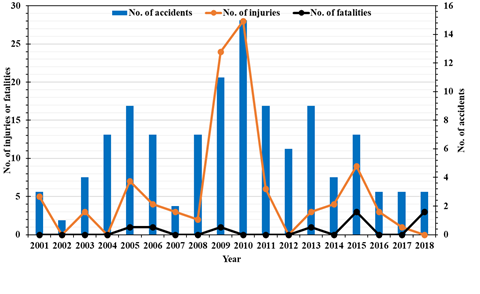
Among the 110 accidents analysed, violating lab procedure is one of the biggest causes of such incidents in China, the study found, where lab safety rules have been implemented but not enforced in many cases. Other reasons behind lab accidents were use of defective equipment, operating errors, hazardous chemicals and lack of supervision.
‘That is unacceptable in my eyes,’ says Imke Schroder, research project manager at the Center for Laboratory Safety at the University of California, Los Angeles (UCLA), which was established in March 2011 following a 2008 incident involving a pyrophoric substance at the institution that resulted in the death of research assistant Sheri Sangji. ‘The infrastructure at the Chinese universities seems to be really below par as compared to here in the US and also UK and other European universities.’
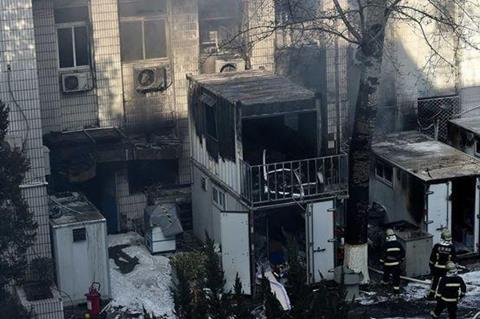
In 2009 and 2010, there was a spike in the number of injuries due to two major incidents, which led to several people being wounded, the study found. One was due to a fire that broke out at the Chinese Academy of Sciences in 2009 that resulted in 10 people being treated after inhaling chlorine. The other was when a gas cylinder exploded at the Liaoning University of Petroleum and Chemical Technology, Fushun, in 2010, injuring 20 people.
It’s ‘quite shocking’ that Chinese universities don’t always have dedicated health and safety departments that conduct regular lab inspections, Schroder says.
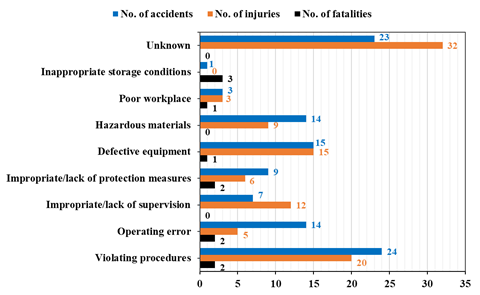
The study reveals that at least 10 people have died and 102 were injured in lab accidents in China in the last two decades but experts warn that the unreported figures could be significantly higher.
Short on data
‘There’s no governmental database about lab accidents,’ notes study co-author Yi Liu, a chemical engineer at the China University of Petroleum in Shandong, referring to this as a limitation of the study. Liu points to the US Chemical Safety and Hazard Investigations Board (CSB) as an example of a government agency responsible for investigating and keeping track of such incidents. Since it was founded in 1998, the agency has made more than 850 recommendations to improve safety across several different fields.

For Liu, reports from bodies like the CSB play a key role in learning lessons on lab safety and avoiding making the same mistakes twice. That’s especially important because most accidents seem to have a human element to them, the study notes. ‘All accidents can be avoidable,’ Liu says.
The lab safety status quo in the US doesn’t put enough emphasis on risk assessments, Schroder says. The UK is a little bit more advanced because academic researchers have to go through a more formalised risk assessment system when an experimental procedure changes, she notes, using forms to ensure that the risks associated with the hazards are controlled. ‘That’s not necessarily what’s done yet in the United States and in my eyes that’s a real problem.’
Craig Merlic, an organic chemist and director of the UCLA’s Center for Laboratory Safety, says that Liu’s study seems to make the ‘mistake of blaming the victim’. Instead, he argues, what’s needed is more thought on what can be done to prevent such incidents from happening in the future. ‘Good science is science done well and science done well is science done safely.’
It’s also not clear from the paper what is classified as an injury, Merlic adds, noting that even at UCLA the only incidents that are recorded are those when someone has to seek medical help or go to a hospital. Near misses are not recorded.
Merlic acknowledges that it’s a difficult topic to collect data on as usually the only accidents that make it into the headlines are the big ones or those where there is a fatality. ‘I’m sure there are thousands of incidents that are significant but they are missing.’
Cultural differences
Merlic says some industries are leading the way by becoming more stringent in reporting lab incidents and then actively trying to prevent similar incidents from taking place in the future. He notes that these firms record even minor injuries such as small cuts from glassware.
Merlic adds that cultures vary between countries when it comes to injuries, accidents and safety. He notes that academic research has shot up in China, with enrolment of graduate students in science, engineering, medicine and agriculture rising rapidly from around 90,000 in 2000 to around 5.3 million in 2019.
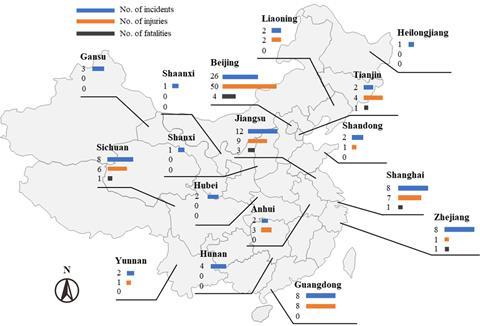
Regional distribution of university lab accidents since 2000
‘That’s incredible,’ he says, noting that it has been difficult for lab safety to keep up. ‘You can’t have growth like that without having growing pains.’ But there isn’t comparable data between academic and industry labs, or between different countries, Merlic says.
Still, China seems to be behind the US on lab safety, says Samuella Sigmann, a retired chemical safety educator in North Carolina. A turning point in the US came after a major 2010 incident at Texas Tech University that resulted in a graduate student losing three fingers, burning their face and hands, and injuring an eye, she says.
In response to the CSB’s recommendation, in 2015 the American Chemical Society’s (ACS) Center for Lab Safety produced guidance describing methodologies on how to assess and evaluate hazards. Sigmann, who was on the ACS committee that came up with the guidelines, notes that the new study suggests that China is heading towards more regulation and rules on safety while the US is moving towards an environment where researchers are able to better protect themselves through knowledge and empowerment.
For instance, in the US, graduate students are assisting each other in peer-to-peer workshops on lab safety, Sigmann says. ‘This problem can’t be solved simply by regulating or training,’ she adds. ‘We’re trying to move people from this mindset of following rules to determining risks.’
In collaboration with the ACS, Sigmann and other safety experts have created a free 15-hour e-learning course on lab safety that has been running for around a year. About half of the roughly 1000 people who have so far completed the course are graduate students based in India, she says, where some professors have mandated that their students take the course in order to complete their degrees. ‘India is another country that has serious incidents and evidently is lagging behind in how they’re educating and training their research chemists.’
Ultimately, Merlic thinks the root cause of the problem worldwide is a lack of commitment from senior institutional leadership to see safety as an important and integral part of building a university.
Merlic commends China for realising the problem exists and starting work to address it. He was part of the team that investigated the 2016 Hawaii incident, producing detailed reports on the hydrogen/oxygen explosion, as well as the Texas Tech one. Merlic notes that those explosions and the 2008 Sangji case at UCLA were all the result of a failure to scale-up reactions properly.
That’s important because if something goes wrong with experiments using large quantities of hazardous substances, the risks can be huge, Merlic says. ‘There’s not enough recognition of the hazards that are created when you go from small scale to larger scale.’
References
M Bai et al, J. Loss Prev. Process. Ind., 2022, 74, 104671 (DOI: 10.1016/j.jlp.2021.104671)
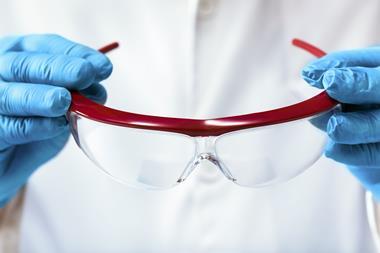

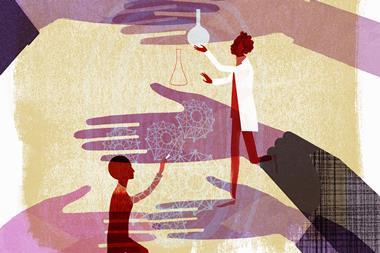
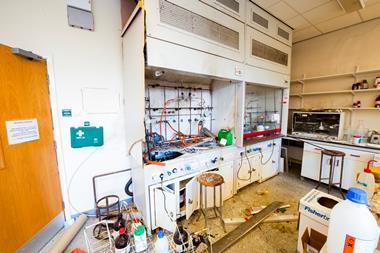








No comments yet